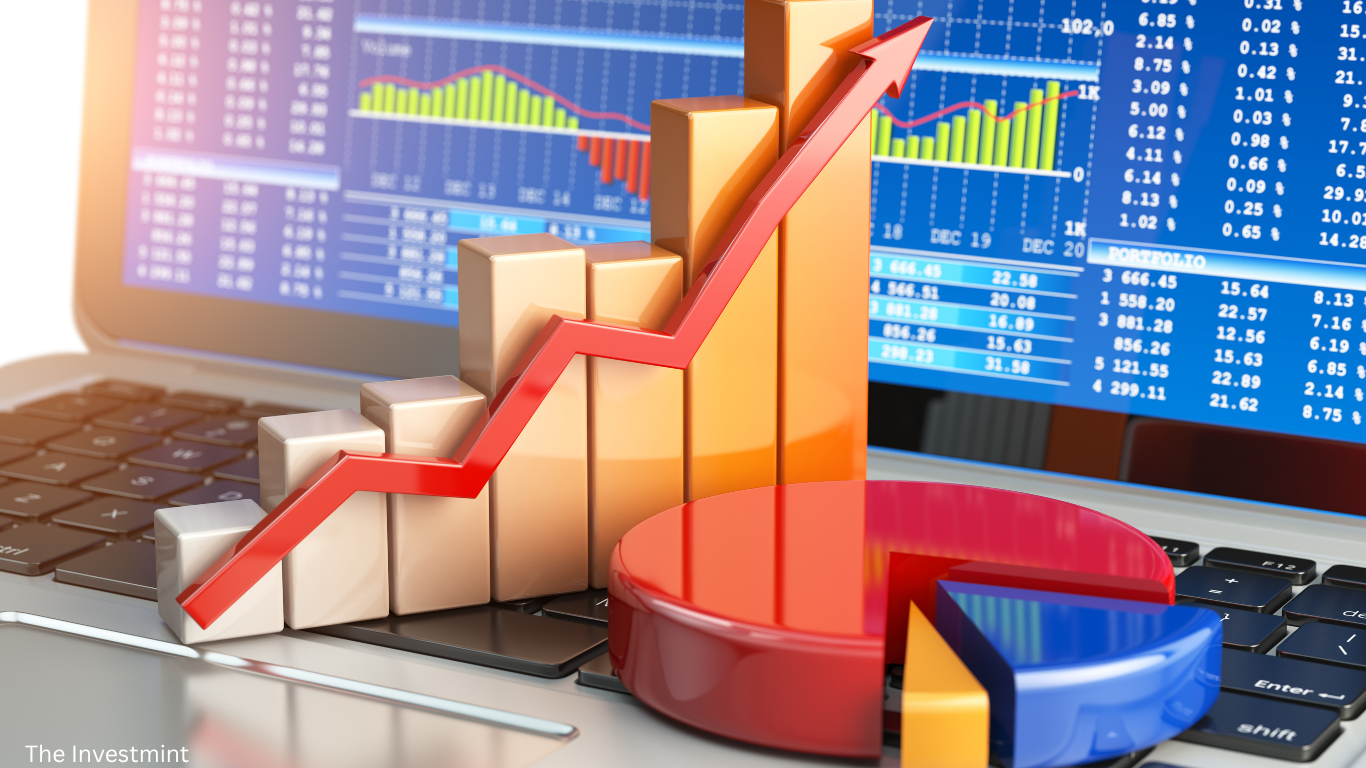1. What Is the Stock Market and How Does It Work?
“Isn’t the Stock Market only for rich people?”
That’s what I used to think.
I imagined people in suits, shouting numbers at giant screens, making or losing crores in a single day. Intimidating, right?
But the truth is far simpler — and way more relatable. The Stock Market isn’t a mysterious world reserved for finance wizards. It’s a place where ordinary people like you and me can grow our savings, invest in brands we love, and build wealth over time. Let’s take a slow, no-jargon walk into this world and understand what the Stock Market really is — and how it actually works.
Table of Contents
2. So… What Is the Stock Market?
Let’s imagine this: Your friend opens a bakery. She wants to expand but doesn’t have enough money. So, she gives you a chance to invest ₹10,000 in her business. In return, you get a share in her bakery — which means you now own a part of it.
That, my friend, is precisely what the Stock Market does — just on a much bigger scale.
The Stock Market is simply a platform where people buy and sell small pieces of companies, which are called shares or stocks. When you buy a stock, you become a part-owner of that company.
Yes — that means you can own a small piece of Tata, Infosys, Apple, or even Zomato.
3. But Why Do Companies Sell Their Shares?
Good question.
Companies need money to grow — maybe to open new factories, build new products, or expand to new countries. So, they raise that money from the public. This process is called an IPO (Initial Public Offering).
After the IPO, their shares start trading in the Stock Market, where people can buy and sell them freely.
You don’t need to meet anyone in person to buy these shares. Everything happens online, through apps like Zerodha, Groww, Upstox, and others.
4. How Does the Stock Market Work — in Plain Language
Let’s break it down using a very real-life example.
4.1 A Company Lists Itself
Imagine a company called ChaiWala Ltd. wants to go public. It offers its shares to the public through an IPO.
4.2 You Decide to Buy Shares
If ChaiWala does well, makes good profits, and gains popularity, more people want to buy its stock. That increases the demand, and the price may rise. Now your ₹100 share could become ₹150 or ₹200.
4.3 The Share Price Changes Over Time
If ChaiWala does well, makes good profits, and gains popularity, more people want to buy its stock. That increases the demand, and the price may rise. Now your ₹100 share could become ₹150 or ₹200.
Similarly, if the company faces losses, its stock price may fall.
And that’s how people make or lose money in the Stock Market.
5. What Makes Share Prices Go Up or Down?
Ah, the million-rupee question.
The price of a stock changes based on a bunch of things — how well the company is doing, what the media is saying, how the economy is moving, and even global events like wars or elections.
But the biggest reason is demand and supply:
If more people want to buy a stock = price goes up.
If more people want to sell it = price goes down.
It’s just like the local sabzi mandi. If mangoes are in high demand but there’s little supply, prices shoot up. Same thing.
6. Who All Are In This Game?
The Stock Market isn’t just you and me. It has a full cast of characters:
Retail investors – Common people like us
Big institutions – Mutual funds, banks, foreign investors
Traders – People who buy and sell quickly to earn fast profits
Long-term investors – People who hold on to stocks for years (think Warren Buffett style)
The beauty? No matter who you are — student, salaried employee, business owner — you can start investing in the Stock Market today.
7. Why Should You Even Care About the Stock Market?
If you’re asking, “Why should I put my money into this?” — here’s why:
7.1 Your Money Grows Faster
Let’s say you keep ₹10,000 in a savings account. In 5 years, maybe you’ll have ₹11,000. But in the Stock Market? That same ₹10,000 can become ₹20,000 or more — if invested smartly.
7.2 Beat Inflation
Every year, the cost of everything — milk, rent, fuel — goes up. This is inflation. The Stock Market helps you grow your money faster than inflation eats into it.
7.3 Own What You Believe In
Love Tanishq jewelry? Invest in Titan. Addicted to Domino’s? Invest in Jubilant Food. Use Airtel every day? Become a part-owner.
You don’t just shop from your favorite companies — you can own them.
8. But What About the Risks?
Let’s be honest — yes, there are risks. It’s not magic.
8.1 Prices Go Up and Down
The stock you buy today for ₹100 can become ₹80 tomorrow. If you panic and sell, you lose money. If you stay calm and wait, it might become ₹150.
8.2 Emotional Investing
People often buy when prices are high (because of FOMO) and sell when prices crash (out of fear). That’s the opposite of what smart investors do.
8.3 Global Events
War in another country, a virus outbreak, or a new tax law — all these can shake up markets overnight.
But here’s the golden rule: Don’t invest money you’ll need next month. Stock Market is for your long-term dreams — not for your emergency fund.
9. Some Common Myths You Should Ignore
Let’s clear the air.
9.1 “Stock Market is gambling”
Nope. Gambling is about luck. The Stock Market is about knowledge, patience, and timing. If you research well, you increase your chances of winning.
9.2 “You need ₹1 lakh to start”
You can start with ₹100. Literally. Many apps even let you invest small amounts in SIPs (Systematic Investment Plans).
9.3 “Only finance people understand stocks”
You learn as you go. Every expert was once a beginner who clicked “Buy” for the first time.
10. Okay, I’m Interested. But How Do I Start?
Here’s your 5-step beginner plan:
10.1 Choose a Broker App
Zerodha, Groww, Upstox, and Angel One are all great for beginners.
10.2 Open a Demat & Trading Account
This is like opening a bank account for your stocks. Easy, free, and fully online.
10.3 Deposit Some Funds
Transfer ₹500 or ₹1,000 from your bank.
10.4 Buy Your First Stock
Start with companies you know. Infosys, HDFC Bank, TCS — companies with good reputation and history.
10.5 Be Consistent
Don’t go crazy buying random stocks. Start slow. Invest monthly. Learn. Repeat.
11. Let’s Learn Some Basic Words (Without Boring You)
Here’s your cheat sheet:
- Share/Stock – A piece of ownership in a company
- Broker – The app/platform you use to buy shares
- Nifty/Sensex – Indexes that show how the market is performing overall
- Portfolio – All your investments combined
- Bull market – When prices are rising (investors are happy)
- Bear market – When prices are falling (investors are sad)
12. In Simple Words: How the Stock Market Works

Companies sell a part of themselves to raise money. People (like you) buy those parts (called shares). If the company grows, so does your money. If the company fails, your money might shrink. That’s the Stock Market — simple, emotional, and full of lessons.
Also read: The History of Stock Market: Fueling Growth for Centuries
13. Quick Summary: Why You Shouldn’t Wait
Reasons:
- You don’t need a finance degree.
- You don’t need a lot of money.
- You don’t need to understand everything on day one.
- You just need the courage to get started.
The Stock Market has changed the lives of many — from regular office-goers to students to small-town entrepreneurs. It’s not a shortcut to get rich quick. But it is a smart way to build wealth slowly and steadily.
14. Final Thoughts: Take That First Step
You’ve come this far. You’ve read patiently. That means you’re ready.
Don’t aim to “time the market” or become an expert in a day. The best investors just show up — consistently. Learn by doing. Invest ₹500. Watch how it moves. Learn again. Invest ₹1000.
That’s how you grow.
Your future self will thank you.
15. Still Got Doubts? Let’s Tackle a Few FAQs
15.1 How much should I start with?
Even ₹100 is okay. Seriously. The important thing is to start.
15.2 Can I lose all my money?
Only if you invest without understanding or chase “hot tips.” Stick with strong companies, and hold for the long-term.
15.3 Is it legal and safe?
100% legal, regulated by SEBI (India’s market watchdog), and safe if you use trusted apps.
15.4 Should I trade or invest?
Trade = fast in, fast out. Risky.
Invest = slow, steady growth. Safer.
If you’re starting out, begin with investing.
Now it’s your turn. Are you ready to become an investor?


Explore a wealth of interesting and practical resources on this site .
From expert articles to bite-sized insights, there’s something to suit all needs .
Stay informed with curated resources built to educate and entertain you .
Here delivers an intuitive navigation ensuring you can discover resources most valuable .
Connect with of like-minded individuals and benefit from our high-quality resources regularly .
Dive in today and unlock wealth of knowledge this platform delivers.
https://represii-by.info